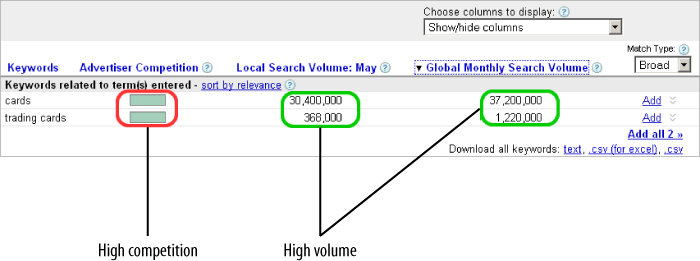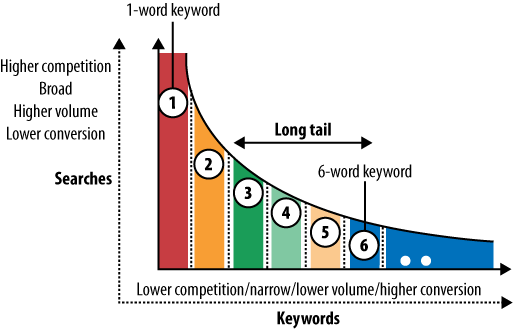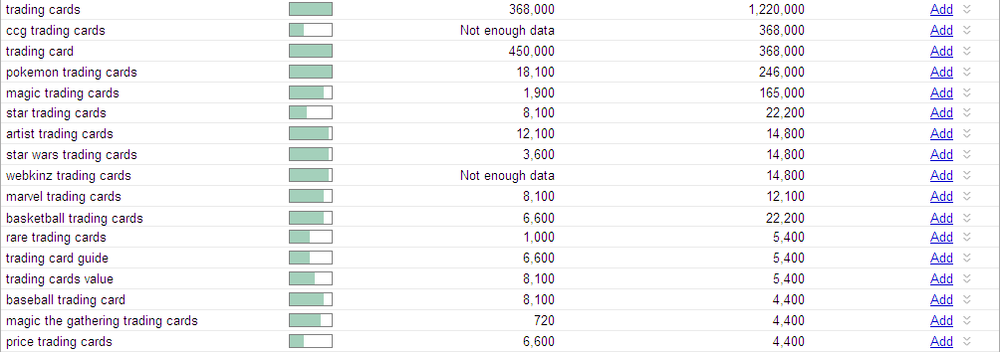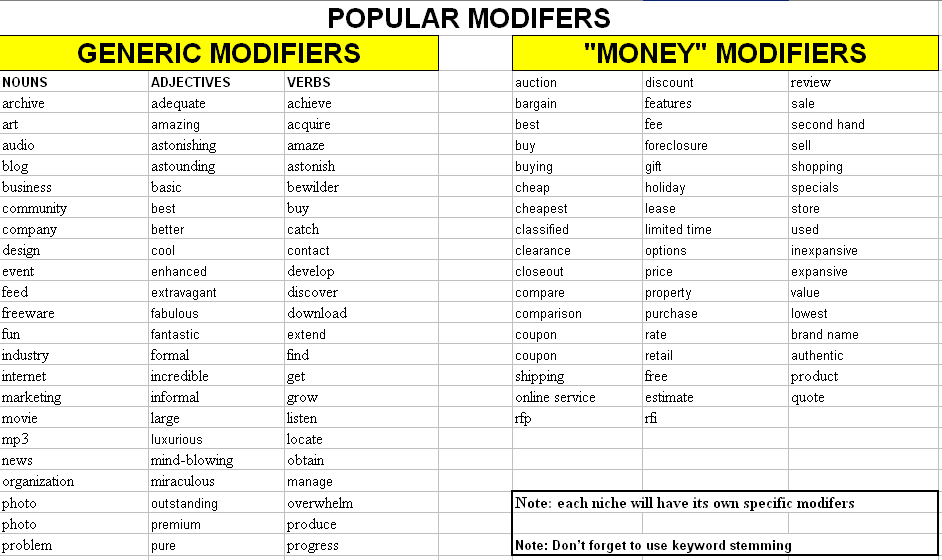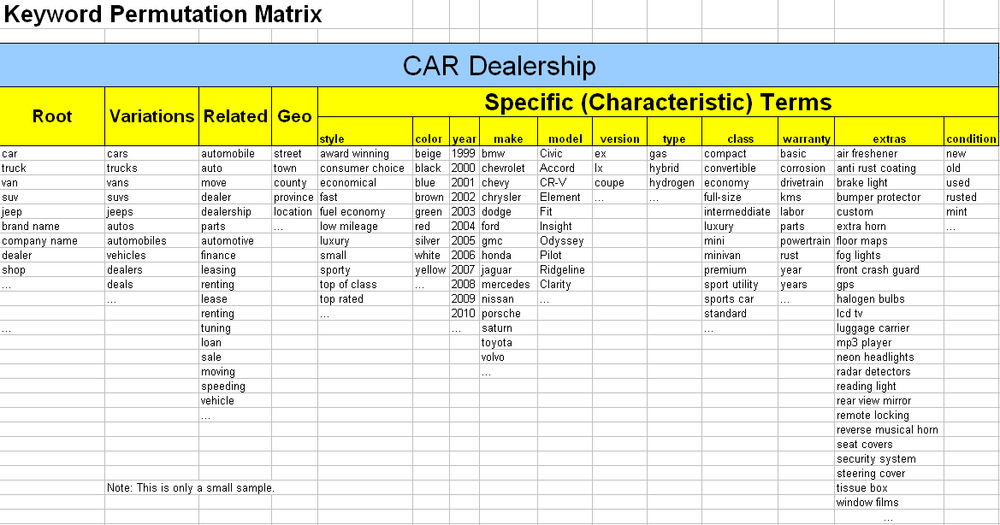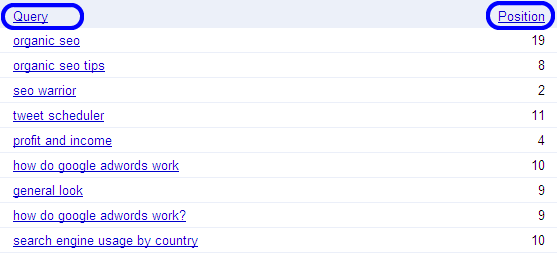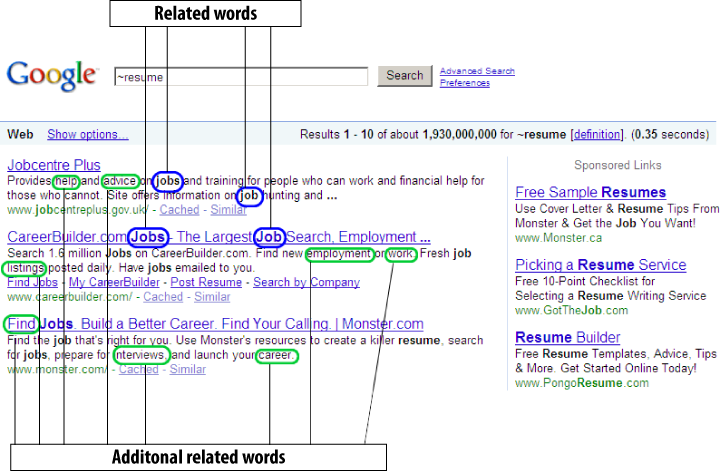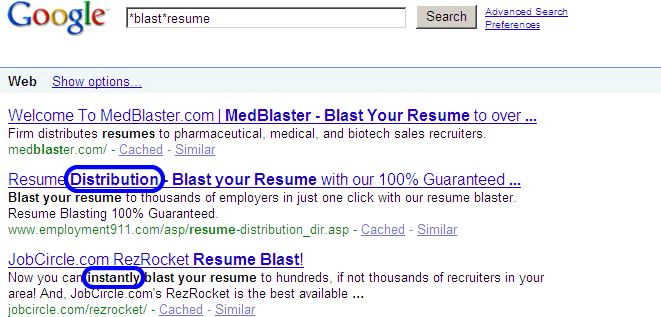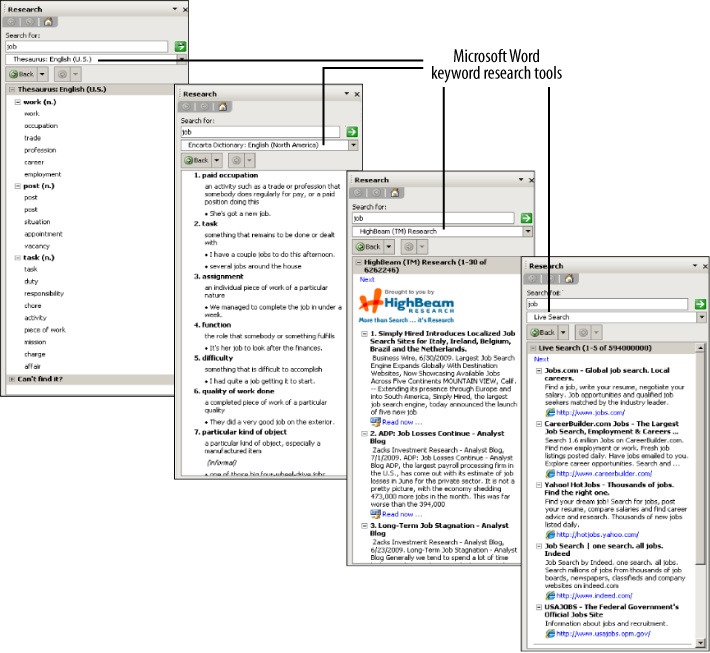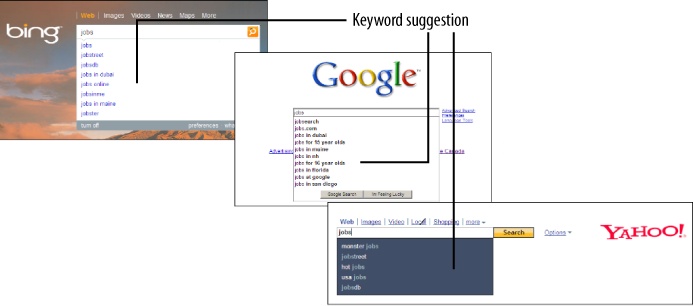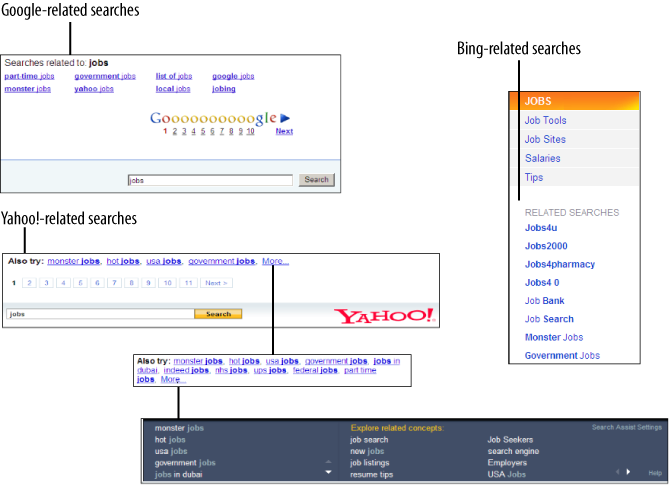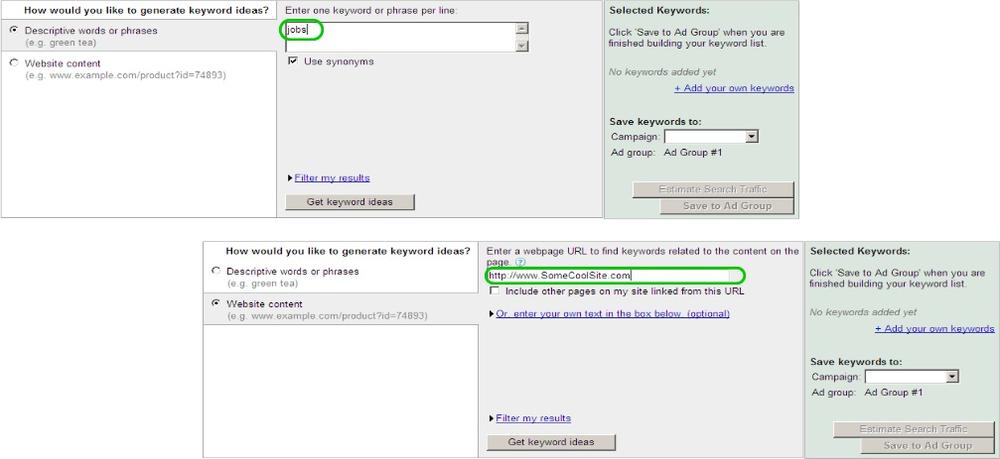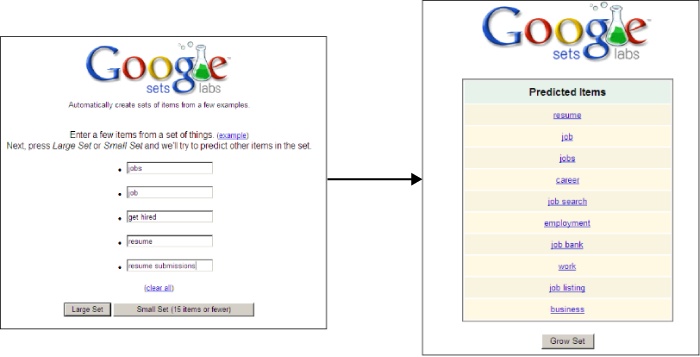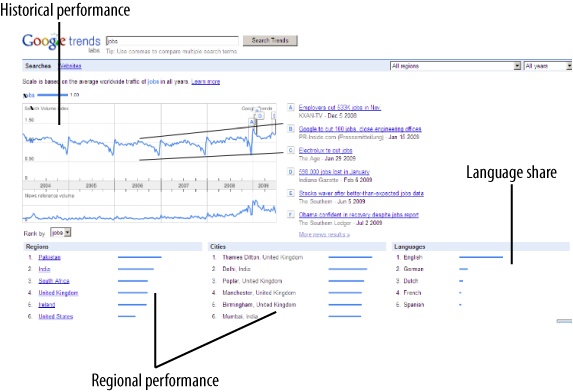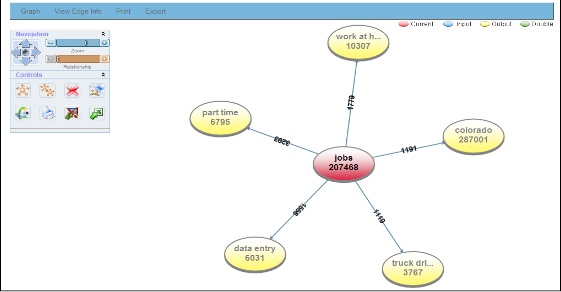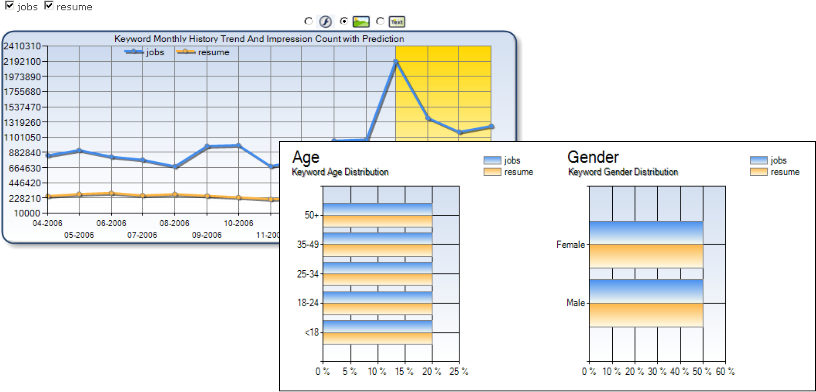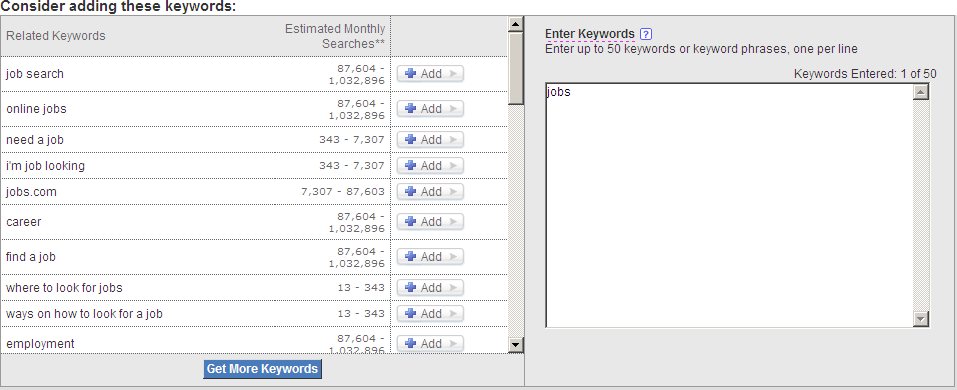Chapter 11. Keyword Research
Although the old days of keyword stuffing are long gone, keywords and keyword research are essential to SEO. In a search engine context, keywords are the words or phrases someone types into the search engine search box to obtain relevant results. Search engines rely on keywords in their search engine ranking algorithms. Keywords indicate relevancy.
As you saw in Chapter 5, keywords are used just about everywhere. In terms of websites, keywords are words or phrases found in your web pages, site and page URLs, and so forth. Before you plow into the world of keyword research, you should have a clear strategy. Targeting one- or two-word keywords may not work as expected due to too much competition.
Picking the right combination of words is important. Search engines have begun to pay attention to page–copy word relationships. With that in mind, it is important to understand the topics of keyword stemming, keyword modifiers, and latent semantic indexing to make intelligent keyword decisions.
Keyword research activities are part of a multistep iterative process. This process usually starts with a keyword brainstorming session, closely followed by utilization of keyword research tools. Some tools are free and some are commercially available. In this chapter, we will examine several popular keyword tools, including the Google AdWords Keyword Tool, Yahoo! Search Marketing, and Microsoft adCenter Labs. No tool is perfect, so it is important for you to get familiar with several tools to make better keyword decisions. The choice between free and paid tools is yours to make, but many people have found the Google AdWords Keyword Tool to be sufficient for their needs.
Evaluating and prioritizing your keyword list is essential. Using keyword search volume numbers as well as their underlying competition numbers can be extremely helpful in keyword selection and prioritization. Before you invest time in using specific keywords, you may want to consider some testing to validate your research.
Keyword popularity is a moving target for many keywords. As they say, one day you are hot, the next day you are not! Some keywords are long lasting, and others are only short lived. Considering keyword trends should be part of your keyword strategy for creating predictable SEO results.
Keyword Strategy
Sound SEO calls for a sound keyword strategy. You need to know what keywords you should target. Creating new pages with arbitrary (untargeted) keywords in your page title, page copy, and so on will not work. You need to be cold and calculating.
Let’s look at an example. Say you want to open an online business selling trading cards. You may be tempted to optimize your page copy for cards or trading cards. Performing a quick search on Google reveals that more than 440 million URLs are competing for the keyword cards and more than 33 million URLs are competing for the keyword trading cards. You can see this in Figure 11-1.
This is only one part of the story. Although the Google results suggest a heavy level of competition, they do not say anything about search volume. This is where you can use the Google AdWords Keyword Tool. Figure 11-2 shows the estimated search volume related to the terms cards and trading cards.
From a strategic perspective, having a high volume of searches is obviously a good thing. But in this case, both sets of keywords are targeted by the competition. In other words, we need to find keywords with less competition to increase our chances of success.
Long Tail Keywords
You can go after two different types of keywords: broad and narrow. Broad keywords are extremely competitive. Narrow keywords are typically attributed to much lower levels of competition.
You may be able to rank for broad keywords. However, ranking high on the first page of Google is very hard to do and requires a lot of effort. As we discussed earlier in this book, the first page of SERPs for a broad keyword search is typically littered with mixed, biased results. Showing up on the third or eleventh SERP is not going to cut it.
Long tail keywords explained
Chris Anderson coined the term the long tail in 2004. Long tail keywords represent the narrow keyword spectrum. Long tail keywords are multiword keywords that are highly specific and narrow in focus. Although long tail keywords do not enjoy the same volume of search traffic as broad keywords, they do enjoy other benefits, such as higher conversion rates and lower competition.
The higher conversion rate is only natural, as in this case web searchers are using several words to express their full intent. This implies that web searchers are using actionable (purpose-driven) keywords and are ready to act on finding satisfactory information on your page.
If your page contains identical search keywords, ideally in the same order, and if you are specifically targeting these keywords, chances are good that your page rank will be higher, as will your conversions.
Lower competition levels mean your site or page will have a higher chance of standing above the smaller crowd. Figure 11-3 illustrates what is meant by long tail keywords.
Implementing a long tail strategy does not mean you should build 10-word keywords. There is a delicate balance between the volume of searches and the number of words in your keywords.
Going back to our example of a trading card business, we could use the AdWords Keyword Tool to get some long tail keyword suggestions. Figure 11-4 shows a portion of a screenshot indicating search volumes of suggested keywords that are related to the keyword trading cards.
As you can see in Figure 11-4, not all keywords have the highest competition (as indicated by the solid green rectangle). Also note that for some suggested keywords, Google does not have sufficient data to show in terms of number of searches. All keyword suggestion tools have questionable accuracy, at best. This is much the case for low-volume keywords as well.
For best results, use at least two (and ideally several) tools. Later in this chapter, we will examine additional ways to figure out your keyword competition.
The question you may be asking at this point is: how many search referrals per month do I need? If your site is new, you will not know the answer to this question. The better question to ask is: how many converting visitors do I need? You should not settle for just any visitor. You want visitors that convert.
So, if you require 1,000 converting visitors with a conversion rate of 10%, this means you require 10,000 visitors. If your conversation rate is lower, you can do the math and see the kind of traffic you need. Compare these requirements with the anticipated traffic of your targeted keywords. Ultimately, your conversion rate is a true indication of the quality of your landing pages, the choice of your keywords, and the quality of your site’s content.
Keywords and Language
A keyword can be any word, found anywhere on your site! This includes nouns, verbs, and adjectives. A keyword can also be a collection of words or a phrase. When creating your keywords, you can use keyword modifiers to create different keyword combinations.
The Importance of Word Stemming
Word stemming refers to the concept of various word derivations from their basic (root) stems. This concept is important, as using it can help in perceived page relevance. Using multiple-word variations can assist you in attaining additional targeted traffic. To quote Wikipedia:
Stemming is the process for reducing inflected (or sometimes derived) words to their stem, base or root form—generally a written word form. The stem need not be identical to the morphological root of the word; it is usually sufficient that related words map to the same stem, even if this stem is not in itself a valid root. The algorithm has been a long-standing problem in computer science; the first paper on the subject was published in 1968. The process of stemming, often called conflation, is useful in search engines for query expansion or indexing and other natural language processing problems.
Let’s look at an example of keyword stemming. When searching for the four-word phrase social network automate tweet, I got the SERP fragment shown in Figure 11-5. If you look closely, it should be clear how Google relates the word stem and its derivative.
Google sees the connection between the search term network and the word networking, as indicated by the boldface words in the SERP result. Google highlights the plural of tweet (my search term) as Tweets. The search term automate is associated with the highlighted result automation. Finally, Google offers the search suggestion of the term automatic.
This example should speak volumes about keyword stemming. Even if your keyword is not an exact match, if it contains either the stem or its grammatical derivative, Google will rank your pages, as they will be perceived as relevant. If your keyword is an exact match, this will typically translate to enhanced page rankings.
Figure 11-6 shows the same article when searching for schedule your tweets. This particular keyword is an exact match of the article. You can see how the page rank improved over the previous example (the four-term keyword).
So, what is the point of keyword stemming? When you write your page copy, be very descriptive while using word variations (singular, plural, various tenses, etc.), and write more descriptive page copy than your competitors.
Keyword Modifiers
Keyword modifiers are words that are used adjacent to your core (root) keywords. Keyword modifiers can help strengthen your long tail keyword strategy. The easiest way to find appropriate keyword modifiers is to start with your basic root words.
Types of modifiers
There are many types of modifiers. Figure 11-7 shows generic and money modifiers. Generic modifiers can be used on any site. These modifiers are usually part of popular search queries. Money modifiers are typically used to catch searches with buying intentions. You can create further subcategories or classifications of modifiers based on the modifiers shown in Figure 11-7.
Niche modifiers
Niche modifiers are modifiers that are specific to a particular industry. Let’s suppose your client owns a small car dealership of new and used cars, and you are in the process of creating a site for this client. When doing your keyword research, you can start by using several root keywords, such as car dealership and car dealer. Your basic root words in this case would be car and dealer.
As part of your keyword research, you should go through the client’s car inventory to determine which cars are selling best. You may also want to determine which options are the most popular.
You can summarize the information you collect in a spreadsheet, as shown in Figure 11-8.
Starting from your root words, you can come up with different term variations and related words (using word stemming, synonyms, etc.). For our car dealer, it is important that the dealer’s geographical information is indexed in the search engines, as its core target audience is its immediate neighborhood.
The next thing you may want to do is to create an inventory of all the cars and associated parts the dealer is selling. In addition, you may want to create several subcategories under which to list all of these characteristics. These may include the car style, color, year, make, version, type, warranty, extras, and condition.
Keyword combinations
As shown in Figure 11-8, you can come up with many different keyword variations. Simply scan the spreadsheet from one side to the other and back, and choose terms from different columns. Create a list of these keyword permutations and add them to your draft keyword list. You may also want to create a small script to create the different keyword permutations for you.
Latent Semantic Indexing (LSI)
Analyzing page copy for keyword density provides a statistical breakdown of the use of each keyword. In the past, search engines used keyword density as one of the most important ranking factors. Although keyword density still plays a role, another keyword relationship technique is coming to the forefront.
Page and site theme
Search engines have started to look at general page and site themes, which are the semantic relationships found on pages throughout a site.
Let’s suppose you are running a sports website, and you are writing an article on the Los Angeles Lakers. The keywords found in this article should be highly predictable. You are likely to talk about specific players, coaches, draft picks, game schedules, the club’s history, the NBA league, and club owners. This should make sense, as all of these things are highly relevant to your overall site theme.
The concept of a page theme is not new, having been developed at Bell Laboratories in 1988. According to Wikipedia:
Latent Semantic Indexing (LSI) is an indexing and retrieval method that uses a mathematical technique called Singular Value Decomposition (SVD) to identify patterns in the relationships between the terms and concepts contained in an unstructured collection of text. LSI is based on the principle that words that are used in the same contexts tend to have similar meanings. A key feature of LSI is its ability to extract the conceptual content of a body of text by establishing associations between those terms that occur in similar contexts.
LSI is also known as Latent Semantic Analysis (LSA). The same article goes on to say that:
LSI overcomes two of the most severe constraints of Boolean keyword queries: multiple words that have similar meanings (synonymy) and words that have more than one meaning (polysemy). Synonymy and polysemy are often the cause of mismatches in the vocabulary used by the authors of documents and the users of information retrieval systems. As a result, Boolean keyword queries often return irrelevant results and miss information that is relevant.
It is easy to see why LSI is becoming a powerful ally to search engines. LSI can help improve the quality of search results. So, what’s the takeaway with LSI? Simply put, create quality pages, and ensure that you create page copy using your main keywords as well as many related keywords. So, if you are writing copy about cat food, for instance, don’t include information on buying electronics unless you are talking about cat tag IDs.
Keyword Research Process
You need to ask several basic questions when conducting sound keyword research. For instance, what would someone type to get to your site? What keywords are associated with your line of business? What would you type to find products, services, and information you are trying to sell? Before you can answer these questions, you must understand your niche or business. The more you know about the business, the more targeted your keyword research will be. Scan through your existing site. If your site is new, use your existing business products, services, and publications for keyword ideas. Find out about your competitors. Learn what keywords they are using. See Chapter 13 for more details.
Establish a Current Baseline
Leverage your web server logfiles to see what keywords are already working for you. Compile a list of current search engine referrals in a spreadsheet such as the one shown in Figure 11-9. You can download the template at http://book.seowarrior.net.
To compile this information you can use several sources, including your web server logfiles, Google Webmaster Tools, and Google Analytics. The most definitive source will always be your web server logfiles. Figure 11-10 shows how this data looks in Google Webmaster Tools.
To find your keyword rankings on other search engines, you can write a script such as the one we will discuss in Chapter 13. You can also use online ranking aggregator services such as those at http://www.url.com/ and http://jux2.com/.
When you have to check many keywords across multiple search engines, it makes sense to automate this task. If you prefer to use graphical tools, you can try those from UPposition, Web CEO Ltd., and Caphyon. Assessing your current rankings is essential for tracking your progress as you modify and grow your site.
Compile a Draft List of Keywords You Wish to Target
If you own an existing site, the keyword process can be a bit simpler. You already know a lot if you have an existing website. You can leverage the existing keywords that you rank for by introducing new keyword variations to catch additional traffic. If you are a new site, this part of the process is lengthier. Let’s assume you are starting a new site.
Keyword brainstorming
For this exercise, let’s imagine we are creating a resume submission service website. Users come to your site, upload their resumes, pay the submission fee, and their resumes get sent to thousands of recruiters. Your target audience is North America and the United Kingdom.
Forget all the tools for a moment. The first thing you want to do is brainstorm your keywords. You want to put down everything you think is related to your business. At this point, you may have a list such as that shown in the following fragment:
resume submission service online resume submission service submit resume to head hunters automated resume submission submit resume to recruiters
At the most basic level, you ought to know your audience. Employ words or phrases that your audience would use to get to your site.
Make use of localized terms
People in different countries speak different versions of the same language. Since your site will also be targeting UK searchers, consider Scottish, UK English, and Welsh terminology. With that in mind, you might add the following keywords for your UK audience:
curriculum vitae submission submit your cv automated cv submission submit cv to job agents
Language is not just different between countries. Languages spoken in different parts of the same country can be significantly different as well, so you will need to keep this in mind.
You can also add geographical keyword modifiers if you want to target keyword queries that include names of cities, towns, and so forth. Some people prefer domestic products and services. Make your sites look (or be perceived as) local. For example, you could add the following:
resume submission service ontario cv blaster london uk resume blaster canada
Utilize keyword stemming
Look closely at all of the keywords we have thus far. Some terms are singular, some are plural, and most are in the present tense. Create some additional combinations based on the keyword stemming we discussed earlier. For example:
submitting your resume blasting your cv automate cv submissions submited your resume to head hunters
Make use of generic keyword modifiers
Here comes the part where you can make further keyword combinations. Your imagination is your only limit. However, your keywords should make sense. Here are some examples of using generic keyword modifiers:
free resume submission better resume blaster easy cv blaster premium resume submission services
Finding related keywords
You can find related keywords in many ways. For example, you
can use Google’s ~ operator to
find semantically related keywords. Figure 11-11 shows Google’s
SERP when you search for keywords related to the keyword
resume.
As shown in Figure 11-11, the keywords
related to resume are jobs
and job, in addition to their uppercase
variations, as the ~operator is
case-sensitive. Note that this is only the first page of the Google
results. You can find more semantically related words by browsing
more Google results pages.
If you look at the SERP closely, you will see many other related terms that you can use. These words are not shown in boldface, like the ones we already talked about, but you can easily realize their relevance. So, we can expand our keyword list to include keywords such as:
job leads with resume submission blast resume to get jobs reach job recruiters find jobs job seeker advice career boost with resume submission services resume blaster career tips cv blaster interview tips
You can also use the star operator, *. The star operator is interpreted as any single term
preceding or following the specified term. Here is an
example:
*blast*resume
Executing this in Google will return results that contain the term blast preceded and followed by any term, then followed by the term resume. Figure 11-12 shows what we get in the Google results.
If you look closely, we have now found a synonym for the term
blast, which is
distribution. We have also found another
keyword modifier: instantly. You can use many
different combinations of the *
operator to learn more related words. This exercise is also about
seeing your competitors’ keyword permutations.
Make use of Microsoft Word
Yes, you read it correctly! Microsoft Word offers a great built-in keyword research tool in its thesaurus and the Microsoft Encarta Encyclopedia. These tools are helpful when building your keyword list. The Word thesaurus is especially good when searching for synonyms and related words. Figure 11-13 shows the kinds of things you can do within Word.
If you are using Microsoft Office, do not overlook Microsoft Word as your keyword research tool. Note that Figure 11-13 illustrates the tools available in Microsoft Office 2003 edition. You may see a different layout or setup in your version.
Using Microsoft Word, I was able to get the following additional terms and keywords that I can use in my keyword combinations:
employment occupation trade profession economic downturn labor market job loss get hired got fired looking for work finding jobs getting interviews recession jobs tough market innovative jobs career change career move
When using the Microsoft Word thesaurus, you can get more words of interest simply by clicking on resulting words. For example, when I type in the word job, I get about 20 synonyms or other related words. I can then click on any of these to get another set of related words. This drill down is virtually endless.
Using search engine keyword suggestions and related searches
Search engines provide an endless pool of keyword suggestions. As soon as you arrive at the search box and start typing your keywords, search engines start showing their search suggestion drop-downs with a list of predicted keywords relevant to your currently typed-in text. Figure 11-14 shows how this looks at the time of this writing on Bing, Google, and Yahoo!.
As soon as you get to your results page, you are again given some keyword suggestions. Figure 11-15 illustrates how this looks in the major search engines. As you can see, there are plenty of keywords you can find just by using search engine interfaces.
The examples shown here are for only a single term. You could run all of your terms and keywords through this process to obtain many new keyword suggestions.
Google keyword tools and resources
Google provides several keyword-oriented tools that you can use for SEO. These include the Google AdWords Keyword Tool, Google Sets, Google Trends, and Google Insights for Search. All of these are free and can be quite useful for obtaining keyword suggestions.
Google AdWords Keyword Tool
The Google AdWords Keyword Tool is perhaps the most popular free keyword research tool. What makes this tool particularly useful is that you can use it for your SEM or SEO campaigns. If you are just doing SEO, you do not need to register to use it.
You can search for related keywords in two basic ways. You can use your own (starting draft) keywords, or you can specify a particular URL from which to obtain your ideas. This includes your competitor URLs as well.
Several filters are available with both methods. Note that the results are tailored for U.S. English by default. You can modify this by clicking on the Edit button. One option allows you to tell Google to discard results containing particular words or phrases. Another option tells Google to include adult words in the suggested results.
You also have the option to just use your own keywords, without requesting suggestions. You would do this if you are only interested in related search traffic information. Figure 11-16 shows the two interfaces. In this case, I am using the keyword jobs as well as a fictitious competitor URL.
After you click the “Get keyword ideas” button, the results come up and you have further options on the righthand side of the screen, where you can change the keyword match type from Broad to Phrase, Exact, or Negative. You can also hide particular columns. Figure 11-17 shows the top six suggested terms for the two scenarios (using some of my keywords and a fictitious competitor URL).
The Google AdWords Keyword Tool is one of the best on the market. Think of it this way: Google has access to most searchers’ data. The company ought to know keywords better than anyone. Some people just use Google AdWords and nothing else!
Google Sets
You can use the Google Sets platform to get additional related keywords. The idea behind Google Sets is that Google will expand the list of your provided keywords by finding related keywords collected from related sets found on the Internet.
Google Sets uses probabilities of finding other keywords next to your keywords when compiling results. Figure 11-18 shows sample Google Sets output. Using Google Sets is easy. Simply enter your related terms and Google does the rest.
Google Trends
The Google Trends platform provides performance timelines for your keywords, as shown in Figure 11-19. You can select particular (world) regions or time frames.
The Google Trends platform also provides the top 100 search queries for a given day. You can see the so-called Google Hot Trends site at http://www.google.com/trends/hottrends. Figure 11-20 shows a sample Google Hot Trends screen as of this writing.
You can also scan Hot Trends back in time and see more details of each keyword by clicking on them.
Google Insights for Search
The Google Insights for Search platform is similar to Google Trends, as it too shows geographical data. You can use Google Insights when comparing keyword performance in specific world regions. Figure 11-21 shows the Google Insights for Search entry form.
When you arrive at the first page of Google Insights for Search, the first thing you want to do is enter your search terms of interest. Next, you may want to modify the default filtering options. For example, you can choose to filter by Web Search, Image Search, News Search, or Product Search.
You can also use Worldwide search or choose a particular country. Finally, you can pick a particular time range. Submitting the form brings up several result sections. These include interest over time (a graph), regional interest (a graph and data), and search terms related to each of your terms. This last item is particularly useful in terms of adding more keywords to your draft keyword list.
Microsoft adCenter Labs
Microsoft is not standing idle while Google continues to produce a new tool every few months. To compete with the Google AdWords Keyword Tool, Microsoft introduced its adCenter Labs platform.
Microsoft’s adCenter provides its own keyword suggestion tool similar to Google’s AdWords and Yahoo!’s Search Marketing keyword suggestion tools. The only catch is that you need to sign up for an account. There is a $5 fee for a new account. Microsoft also offers free online tools under its adCenter Labs platform.
The adCenter Labs platform comes with many features. The ones specific to keyword research include entity association graph capability, keyword group detection, keyword mutation detection, keyword forecast capability, and search funnels.
Entity association graph
According to Microsoft, the entity association graph is a graphical representation of “co-occurrences of entities in search queries or search sessions”. In other words, this tool should be useful for getting additional keyword suggestions. Figure 11-22 shows the entity association graph for the term jobs.
Keyword group detection
The keyword group detection tool shows words that are related to or similar to keywords entered on the keyword group form. The resulting output shows a long table of related words. At the time of this writing, a search for words related to jobs yields the following keywords:
job opportunities job listings job search employment opportunities government jobs zip codes employment agencies phone book employment federal jobs job openings toyota dealers nursing jobs job fairs phone directory culinary schools yellow pages ...
Keyword mutation detection
The keyword mutation detection tool produces common misspellings and alternative spellings. When searching for the word resumes, I got the following misspellings:
reume resumes reseme resum resume's
When it comes to misspellings, if you need to use them, stick them in your meta keywords. Misspellings found on your page copy do not look professional.
Keyword forecast
The keyword forecast tool predicts keyword searches (an impression count) and the associated demographic distributions of entered keywords. Figure 11-23 is a sample illustration for the terms jobs and resume.
Search funnels
You use search funnels to analyze related search sequences. Figure 11-24 shows an example search funnel for the term jobs.
Yahoo! keyword tools
Yahoo! offers a couple of platforms: Yahoo! Research and Yahoo! Search Marketing (the latter being the AdWords Keyword Tool alternative).
Yahoo! Research
Yahoo! Research provides a platform called Sandbox where it runs many different projects. When it comes to keyword-related projects, there are two interesting tools: Correlator and TagExplorer. You can use both to get additional keyword suggestions.
Yahoo! Search Marketing
The Yahoo! Search Marketing platform provides another PPC keyword tool that you can use for SEO work. Its interface is similar to Google AdWords and you can find it at http://sem.smallbusiness.yahoo.com/searchenginemarketing/. Figure 11-25 shows keywords that Yahoo! Search Marketing suggested based on the keyword jobs.
As of this writing, you do not need to register to use Yahoo!’s keyword suggestion tool.
Additional keyword research tools
Many companies provide free and commercially available keyword research tools. This section mentions some of the popular ones. You can try a few tools and find one or two that you like. Then you can use those tools in conjunction with the Google AdWords Keyword Tool for most of your work.
Free keyword research tools
Table 11-1 lists some of the popular free online keyword research tools.
Commercially available keyword research tools
Table 11-2 lists some of the commercially available online keyword research tools.
Evaluate Your Keywords
Assuming you have compiled your draft list of keywords, you should now group your keywords in order of priority. You want to target keywords that have sufficient search volume as well as those you think will convert. To determine keyword priority, you need to do a bit more research.
Estimating keyword competition, revisited
This chapter started with an example of searching for the keyword trading cards, which told us that Google indexed more than 37 million related results. This number does not help much, as we know Google does not show more than 1,000 results per search query.
What we really want to know is how many pages (or sites) are targeting our keywords of interest. More specifically, we want to know how many pages are targeting the keywords we compiled on our list. The kinds of pages we are looking for are those that contain keywords in the page title, in the page URL, and in the link anchor text.
Google provides search command (operators) that can help us
see how many URLs are targeting our keywords of interest. The three
most important keyword operators are intitle:, inurl:, and inanchor:. Table 11-3 shows an analysis for the keyword
trading cards.
Search command | Relative index size |
| 37,200,000 |
| 5,400,000 |
| 1,990,000 |
| 6,270,000 |
| 5,400,000 |
| 1,840,000 |
| 91,000 |
| 75,000 |
| 37,000 |
| 5,750 |
| 738 |
The point of Table 11-3 is to drill down to the results that are seriously targeting our keyword. Adding the keywords star wars and star wars han solo brings the Google index down to 738 results.
If we execute similar commands on Yahoo!, we get the results shown in Table 11-4. Note that Yahoo! does not support
the inanchor: operator.
Search command | Relative index size |
| 127,000,000 |
| 977,000 |
| 344,000 |
| 355,000 |
| 236,000 |
| 219,000 |
| 85,000 |
| 36,500 |
| 136 |
As you can deduce from Yahoo!’s numbers, Yahoo! claims to have more results than Google. But when you drill down with additional criteria, the numbers dwindle down much faster, suggesting inflated index counts.
The takeaway from this exercise is to run your keywords through similar commands to spot any interesting opportunities. You want to target keywords that have a relatively low number of indexed URLs—that is, when your keywords are found in the HTML title, the URL path, and the link anchor text in your competitors’ pages.
You can utilize a spreadsheet for easier comparison and tracking. Figure 11-26 illustrates one template you can use in your work. This template is just another tab of the same spreadsheet we discussed earlier in the chapter.
You can also automate these tasks by writing an automated script. Be mindful of search engine resources. Strive to emulate regular human clicking behavior in your script.
Estimating keyword search volume
The biggest challenge in the keyword research process is making keyword search estimates. Most of the available tools are pretty good at estimating highly popular broad keywords. When it comes to long tail keywords, it may be best to use one- or two-week PPC campaigns to get some real numbers. Remember, PPC platform vendors will provide you with accurate numbers, as that is in their interest. You can always check their stats claims by carefully examining your web server logfiles.
Employing PPC to estimate your search traffic is one thing. You can also test your keywords for particular conversions. You can set up PPC campaigns to target specific keywords and see whether they work. Utilizing PPC techniques to forecast your SEO conversions can save a lot of time and money, as you can get fast feedback that will allow you to adjust your keyword strategy. Taking out the guesswork pays off in the long run. We will discuss PPC in more detail in Chapter 16.
Finalize Your Keyword List
Perhaps you have done your homework. You have spent time researching your business. In the process, you have utilized several keyword research tools to get the best keywords available. You may have also tested your keywords in a small PPC campaign and have found those that work. You are now ready to implement your keyword list within your content.
Implement Your Strategy
Implementing a keyword strategy simply means optimizing your content for your researched keywords. It takes time to see your results, as they depend on many factors, including your site and page age, your site’s trust factor, and many others.
Your keyword research strategy could be to push all of the modified or new content at once, or to create a scheduled content strategy—to target additional keywords over time. Once your content is out, all you can do is wait and see. Monitor your web stats using Google Analytics and other tracing software. Perform a current keyword state assessment audit to see your progress. Perform corrective action on your low-performing keywords. Readjust your keyword list. Repeat the process as required.
Summary
Keyword research activities are the foundation of intelligent SEO. Targeting the wrong keywords can be costly. Regardless of whether you are a new or an old site, spend time conducting appropriate keyword research.
Search engines provide many different tools and resources that you can use to create your keyword lists. Gradually increase your targeted keyword base. Diversify over time to build your web presence. Focus on one keyword per page. Stick your keyword misspellings in your meta keyword HTML tags. Study your web logs and web stats extensively.


